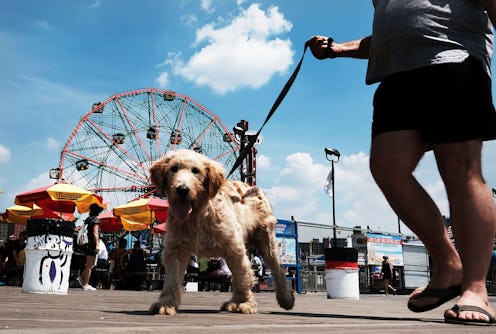Life
7 Signs Your Dog Might Have Heat Stroke

Though pups are playful and energetic creatures, always ready to play fetch or go to the dog park, they can overheat — especially during the hot summer months. If it's too hot for you to be outside for too long, there's a good chance it's also too hot for your dog to be out for an extended period of time. Just like people, dogs can have heat stroke or heat exhaustion due to overexertion, or environmental factors such as summer weather.
"You probably wear a tee shirt and shorts in the summer, but your dog has an extra layer of fur. Imagine wearing a fur coat" during the summer, Dr. Daniel Edge, the director of veterinary specialty operations at Zoetis Petcare, explains to Bustle. Not super comfortable — and potentially dangerous.
Heat stroke in dogs can cause long lasting organ damage, and can be fatal. In fact, a 2006 study estimated a 50 percent mortality rate within the first 24 hours for dogs experiencing heat stroke. Further, according to the American Veterinary Medical Association (AVMA), hundreds of dogs die every year in the U.S. from heat exhaustion after being left in a hot car. And, thousands more are hospitalized for heat-related health issues every year. So, recognizing the early signs your pup is too hot can be crucial to ensuring they stay healthy.
If you are unsure of how to tell if your dog is experiencing heat exhaustion, these are seven signs experts say to watch out for, as well as what to do if your fear the rising temps and hot sun are jeopardizing your pet's health.
1Excessive Panting
"Heat exhaustion is when a dog’s body temperature rises above the high end of normal — above 103 degrees — because the dog’s normal mechanisms for thermoregulation and cooling (e.g. panting) are overwhelmed," Dr. Lori Bierbrier, the medical director of ASPCA Community Medicine, tells Bustle. Because of this, she explains that dogs with heat exhaustion will usually present with excessive panting in an attempt to cool down.
"Panting is the primary way that dogs cool their body," Dr. Bierbrier says. "With an early concern about heat exhaustion, remove your dog from the hot environment and let them pant out excessive heat in a controlled and cooler space, such as an air conditioned room."
2Lethargy
Lethargy and disinterest can be a symptoms of many different health issues in dogs, but Dr. Edge says that "sudden lethargy may be an early sign your dog has heat stroke, or heat exhaustion."
If you notice your dog is acting lethargic or fatigued, Dr. Edge says one thing you can do is "wet a towel with tepid water, and place it on your dog's skin to cool them down." However, it's super important to note you should definitely use "tepid" water versus cool water, because water that's too cold can shock your pet's system, and cause hypothermia.
3Collapsing
In addition to lethargy, Dr. Bierbrier tells Bustle your dog could be so weak due to heat exhaustion that they may collapse. If this happens to your furry friend, she says to "provide them with a cool place to lie and rest — such as a tile floor or cool concrete — where heat can disperse."
4Neurological Symptoms
According to an article written by Dr. Alex Betzen for Westbury Animal Hospital, "In the initial period [of heat exhaustion], many dogs show some form of neurologic disease. Affected dogs often have a 'dull' or dazed attitude." If you are out with your furry friend enjoy the summer weather, but they start acting strange, that's your cue to head inside somewhere cool.
5Change In Tongue Or Gum Color
Dr. Bierbrier explains that a bright red tongue and gums are both possible signs your dog may have heat exhaustion. What's more, Dr. Edge adds that your pup's gums could appear to be a bluish color, rather than reddish. The bottom line is, any kind of gum or tongue discoloration could indicate your dog is overheating, and is in need of veterinary care, as well as a cool environment and water.
6Rapid Heart Rate
One of the first signs of heat exhaustion in your dog, Dr. Bierbrier warns, is "increased heart and respiratory rates." This symptom may be a little more difficult to pinpoint — especially if your pet is running around at the park — but it's still important to be aware of it.
7Nausea
Though Dr. Edge says nausea in dogs is hard to identify because it is a "self-reporting symptom," he says dogs that have an upset stomach will often excessively salivate and, of course, vomit. If the onset of nausea happens to occur while you're outside in the warm weather, or presents with these other symptoms, it could be a clue your dog has heat exhaustion.
"Definitely seek veterinary care, even if you believe you have your dog's heat stroke symptoms under control," says Dr. Edge, explaining that while you might get visible symptoms under control, your dog's core body temperature may still be elevated.
Be sure to always take precautions — like limiting outside playtime during the summer, bringing a water bottle for your dog, and never leaving them in a hot car — to avoid dealing with a heat-related emergency in the first place. Heat exhaustion is common scare for pet owners in the summer, but recognizing the signs and acting quickly can make all the difference.